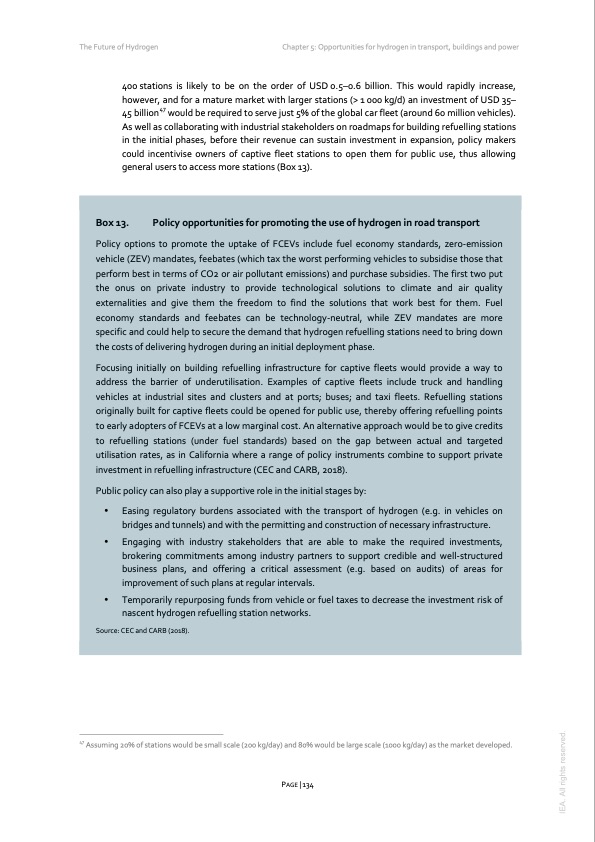
PDF Publication Title:
Text from PDF Page: 134
The Future of Hydrogen Chapter 5: Opportunities for hydrogen in transport, buildings and power 400 stations is likely to be on the order of USD 0.5–0.6 billion. This would rapidly increase, however, and for a mature market with larger stations (> 1 000 kg/d) an investment of USD 35– 45 billion47 would be required to serve just 5% of the global car fleet (around 60 million vehicles). As well as collaborating with industrial stakeholders on roadmaps for building refuelling stations in the initial phases, before their revenue can sustain investment in expansion, policy makers could incentivise owners of captive fleet stations to open them for public use, thus allowing general users to access more stations (Box 13). Box 13. Policy opportunities for promoting the use of hydrogen in road transport Policy options to promote the uptake of FCEVs include fuel economy standards, zero-emission vehicle (ZEV) mandates, feebates (which tax the worst performing vehicles to subsidise those that perform best in terms of CO2 or air pollutant emissions) and purchase subsidies. The first two put the onus on private industry to provide technological solutions to climate and air quality externalities and give them the freedom to find the solutions that work best for them. Fuel economy standards and feebates can be technology-neutral, while ZEV mandates are more specific and could help to secure the demand that hydrogen refuelling stations need to bring down the costs of delivering hydrogen during an initial deployment phase. Focusing initially on building refuelling infrastructure for captive fleets would provide a way to address the barrier of underutilisation. Examples of captive fleets include truck and handling vehicles at industrial sites and clusters and at ports; buses; and taxi fleets. Refuelling stations originally built for captive fleets could be opened for public use, thereby offering refuelling points to early adopters of FCEVs at a low marginal cost. An alternative approach would be to give credits to refuelling stations (under fuel standards) based on the gap between actual and targeted utilisation rates, as in California where a range of policy instruments combine to support private investment in refuelling infrastructure (CEC and CARB, 2018). Public policy can also play a supportive role in the initial stages by: Easing regulatory burdens associated with the transport of hydrogen (e.g. in vehicles on bridges and tunnels) and with the permitting and construction of necessary infrastructure. Engaging with industry stakeholders that are able to make the required investments, brokering commitments among industry partners to support credible and well-structured business plans, and offering a critical assessment (e.g. based on audits) of areas for improvement of such plans at regular intervals. Temporarily repurposing funds from vehicle or fuel taxes to decrease the investment risk of nascent hydrogen refuelling station networks. Source: CEC and CARB (2018). 47 Assuming 20% of stations would be small scale (200 kg/day) and 80% would be large scale (1000 kg/day) as the market developed. PAGE | 134 IEA. All rights reserved.PDF Image | The Future of Hydrogen 2019

PDF Search Title:
The Future of Hydrogen 2019Original File Name Searched:
the_future_of_hydrogen.pdfDIY PDF Search: Google It | Yahoo | Bing
NFT (Non Fungible Token): Buy our tech, design, development or system NFT and become part of our tech NFT network... More Info
IT XR Project Redstone NFT Available for Sale: NFT for high tech turbine design with one part 3D printed counter-rotating energy turbine. Be part of the future with this NFT. Can be bought and sold but only one design NFT exists. Royalties go to the developer (Infinity) to keep enhancing design and applications... More Info
Infinity Turbine IT XR Project Redstone Design: NFT for sale... NFT for high tech turbine design with one part 3D printed counter-rotating energy turbine. Includes all rights to this turbine design, including license for Fluid Handling Block I and II for the turbine assembly and housing. The NFT includes the blueprints (cad/cam), revenue streams, and all future development of the IT XR Project Redstone... More Info
Infinity Turbine ROT Radial Outflow Turbine 24 Design and Worldwide Rights: NFT for sale... NFT for the ROT 24 energy turbine. Be part of the future with this NFT. This design can be bought and sold but only one design NFT exists. You may manufacture the unit, or get the revenues from its sale from Infinity Turbine. Royalties go to the developer (Infinity) to keep enhancing design and applications... More Info
Infinity Supercritical CO2 10 Liter Extractor Design and Worldwide Rights: The Infinity Supercritical 10L CO2 extractor is for botanical oil extraction, which is rich in terpenes and can produce shelf ready full spectrum oil. With over 5 years of development, this industry leader mature extractor machine has been sold since 2015 and is part of many profitable businesses. The process can also be used for electrowinning, e-waste recycling, and lithium battery recycling, gold mining electronic wastes, precious metals. CO2 can also be used in a reverse fuel cell with nafion to make a gas-to-liquids fuel, such as methanol, ethanol and butanol or ethylene. Supercritical CO2 has also been used for treating nafion to make it more effective catalyst. This NFT is for the purchase of worldwide rights which includes the design. More Info
NFT (Non Fungible Token): Buy our tech, design, development or system NFT and become part of our tech NFT network... More Info
Infinity Turbine Products: Special for this month, any plans are $10,000 for complete Cad/Cam blueprints. License is for one build. Try before you buy a production license. May pay by Bitcoin or other Crypto. Products Page... More Info
| CONTACT TEL: 608-238-6001 Email: greg@infinityturbine.com | RSS | AMP |